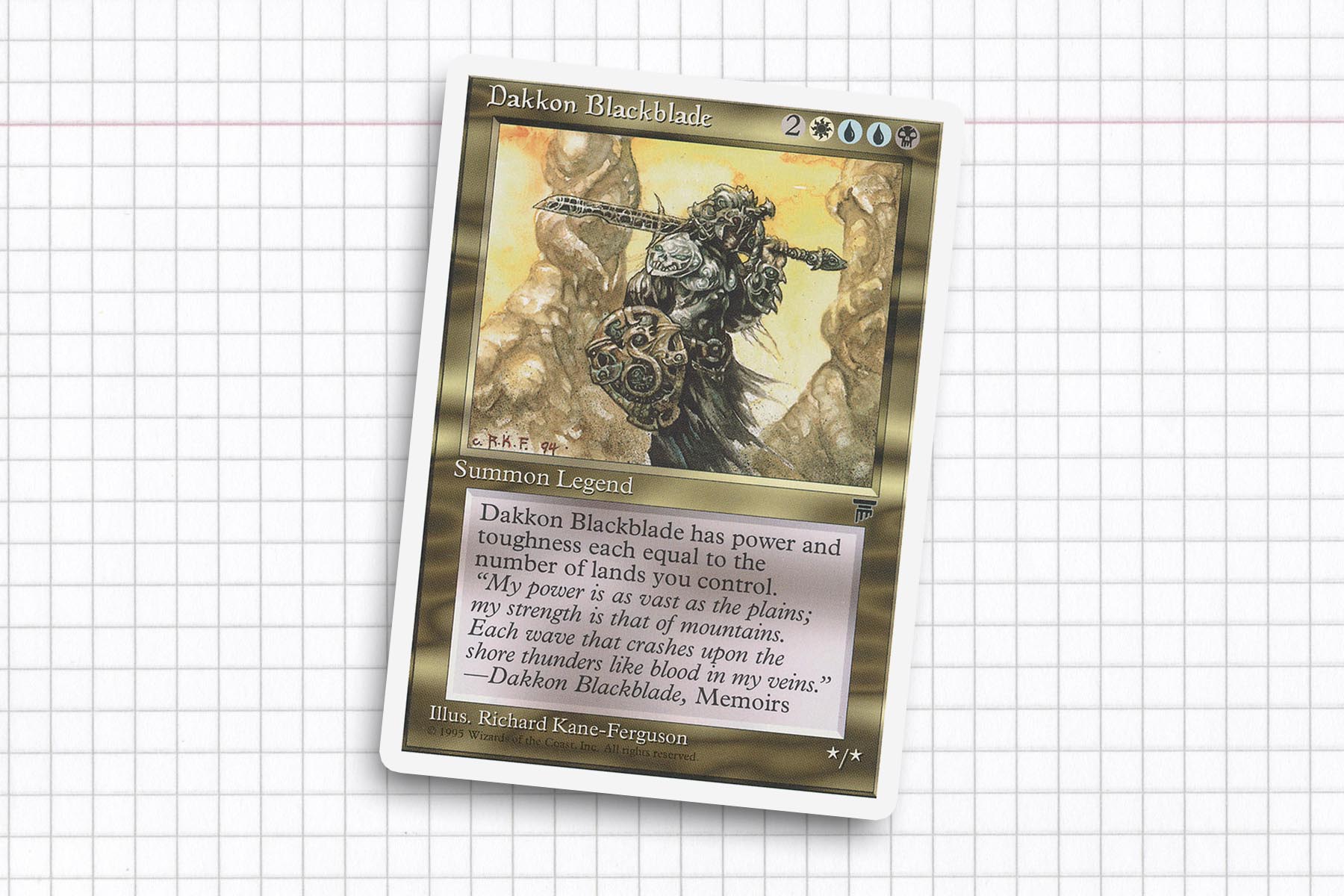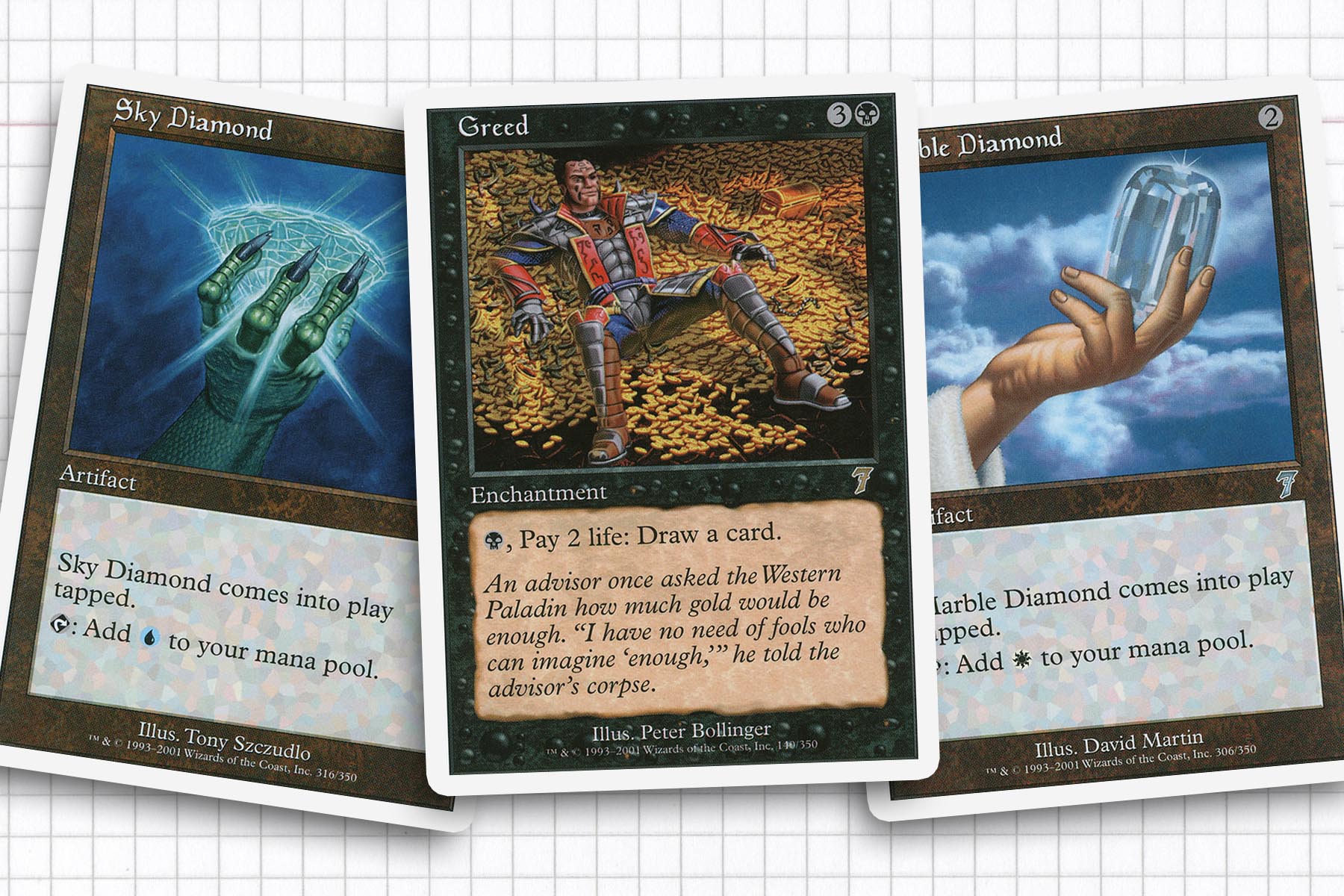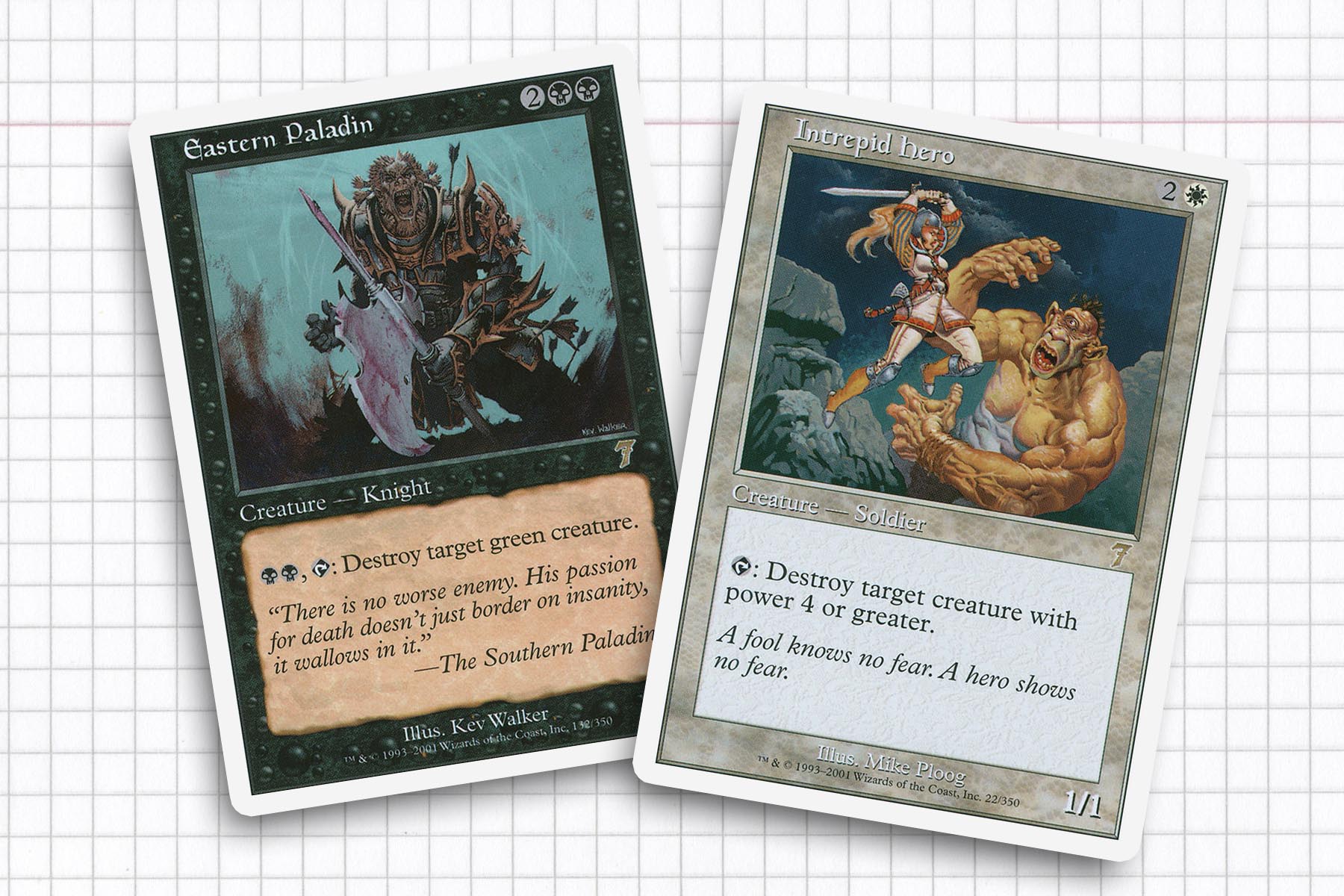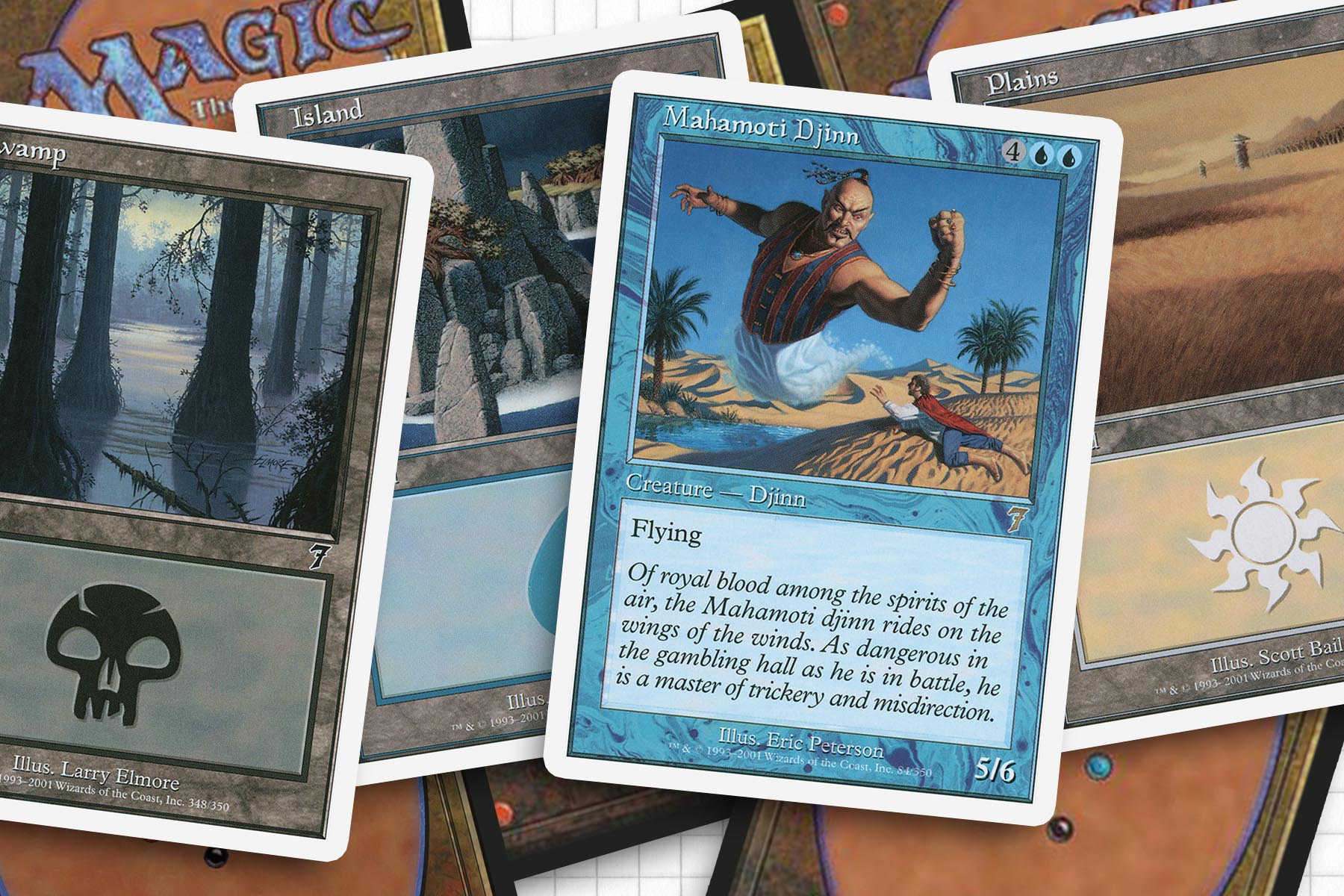Welcome everyone, to the final installment of what I have called Seventh Edition September. In coordination with Hipsters of the Coast’s 10th anniversary, I wanted to celebrate my 20th anniversary playing Magic by reflecting back on the set that started it all for me.
I knew that I wanted to spend at least one of my installments actually focusing on Commander, and I figured that the funnest way to do that would be to take on the challenge of building an entire Commander deck using cards found within Seventh Edition exclusively. The only exception to this being that I needed to find a legendary creature that was appropriate from outside of the set. It wasn’t until Magic 2013 that we would even see legendary creatures in a Core set, so I was fated to make this decision, regardless.
I decided to carry on using white borders, which to my knowledge would be exclusively legendary creatures from Chronicles. For me, the choice of Dakkon Blackblade was an easy one. While the runner-up, Sol’kanar the Swamp King, certainly has their merits, Dakkon has the right power level to both fit my needs and possess enough agency to keep the game moving. We’ll get to play with a few staples that still hit the table today, while answering most threats in unique ways.
I hope this challenge strikes a chord, because at the end of the day, I really like where I landed and don’t know that there is really much improvement that could be done, due to the limited card pool.

Commander: Dakkon Blackblade
Creatures: Archivist, Benthic Behemoth, Cloudchaser Eagle, Daring Apprentice, Eastern Paladin, Fallen Angel, Glacial Wall, Gravedigger, Intrepid Hero, Kjeldoran Royal Guard, Mahamoti Djinn, Merfolk Looter, Phantom Warrior, Prodigal Sorcerer, Razortooth Rats, Serra Angel, Southern Paladin, Standing Troops, Stronghold Assassin, Telepathic Spies, Temporal Adept
Artifacts: Charcoal Diamond, Howling Mine, Marble Diamond, Sisay’s Ring, Sky Diamond, Soul Net, Spellbook
Enchantments: Circle of Protection: Green, Circle of Protection: Red, Confiscate, Fear, Greed, Holy Strength, Leshrac’s Rite, Levitation, Pacifism, Serra’s Embrace, Spirit Link, Steal Artifact, Strands of Night, Unholy Strength, Yawgmoth’s Edict
Instants: Boomerang, Counterspell, Disenchant, Force Spike, Hibernation, Memory Lapse, Opportunity, Tolarian Winds, Unsummon
Sorceries: Baleful Stare, Befoul, Corrupt, Duress, Fugue, Mind Rot, Purify, Sleight of Hand, Soul Feast, Wrath of God
Lands: 13 Island, 11 Plains, 10 Swamp, Adarkar Wastes, City of Brass, Underground River
After deciding on Dakkon Blackblade, I examined the card pool we were working with and identified that some form of Voltron strategy would be salvageable using Fear, Holy Strength, Leshrac’s Rite, Serra’s Embrace, Spirit Link, and Unholy Strength. Because of his ever increasing size, Dakkon on his own can be very formidable, this is going to be very helpful for pushing through damage. Fear, Leshrac’s Rite, and Serra’s Embrace are the most important auras on this deck, because they grant the evasion we will need to really take advantage of our general.

Still Have All These
For as laughably low-powered as Core Set cards from the early 2000s can be, it’s hard to debate that cards like Wrath of God, Disenchant, and Counterspell, which still remain in the Top 100 for their respective colors in Commander, aren’t worthy of spots in this list. I was unaware of Charcoal Diamond, Marble Diamond, and Sky Diamond seeing print in Seventh Edition; probably because I had such horrible card assessment skills when I started, that I didn’t consider them worth my time. But they are the kind of ramp I’m looking for in a lot of non-green budget decks I try to assemble in 2022.
Even outside of the hyper specific Top 100 for a color or card type, I’m willing to play cards like Greed, Memory Lapse, Opportunity, and Sisay’s Ring in a lot of decks anyway. Strands of Night is a very interesting reanimation card that I rediscovered late last year that has really thrived in heavy black decks. In this deck, it might have lost some of its potency, but it’s going to allow us to have some rebuilding potential in a metagame of far more adaptive creature bases.
After finally completing this deck I had a little bit of a crisis. Truth be told, I really felt like I was building something that was completely unremarkable and genuinely considered changing the confines of how I was going to construct this deck. I was looking at all the cards that just existed in the old frame and saying, “what if I only restricted myself to the old frame?”
But then I realized how easy it would be to quickly cut out cards like Benthic Behemoth and Eastern Paladin, simply because they weren’t up to snuff against things from Urza’s Saga or Invasion block. This is also at the heart of why Dollar General can be some much fun:
Dollar General—[dol-er] [jen-er-uhl]
A variant of the Commander format, itself a casual multiplayer variant format for Magic: the Gathering with specific rules centered around a legendary creature called a General. The additional layer being that every card comprising a 100-card deck must cost less than a US dollar.
Being able to get a use out of cards like Hibernation or Tolarian Winds is gratifying in its own right. And while this deck might not hit all card draw, removal, and ramp metrics most decks are generally expected to attain, it has enough analogs to popular cards to really encompass a retro Magic aesthetic, while still feeling like it could play a competent game of Commander.

Something All Its Own
I have certainly fallen prey to power creep over the course of the last decade. For as much as I wanted to build decks that felt like they were individual and left a mark that only I could have created, it became so easy to identify staple cards and acquire them in bulk. But a deck built around a theme such as this does have that individualistic quality that has kind of been lost in a lot of the decks that I have personally built over the last few years. This deck will not win games easily, though Dakkon Blackblade is capable of being rather impressive given the right auras. It will set the tone that I am sitting down to play a game with my friends rather than trying to win sporadically on turn seven.
I don’t know that I have ever cast Archivist in Commander, and while I would much rather have Arcanis the Omnipotent, I admittedly only play the legendary wizard in Mairsil, the Pretender. In so many games, wouldn’t Archivist have a similar impact to Phyrexian Arena? While niche in their effects, Eastern Paladin, Intrepid Hero, and Southern Paladin all destroy Atraxa, Praetors’ Voice and Korvold, Fae-Cursed King just as easily as Beast Within or Anguished Unmaking would.
The contrarian in me also gets a certain amount of joy thinking of the idea of casting cards like Fugue, Mind Rot, and Soul Feast, which by today’s standards are completely inefficient and laughable, due to only targeting one specific player. But at the same time, my Borborygmos Enraged deck used single target removal like Lightning Bolt and Pillar of Flame, simply due to the fact that they removed things I didn’t like and generally got a chuckle. And in that ability to just let go of min-max mindsets, I really began to appreciate what I’d built here.

That Unique Look
In my tenure, I have peppered in my own thoughts about how unifying a carefully curated aesthetic can be for a deck. For the most part this is easiest to establish in the mana base, because you can capture the feel of a deck through the use of basic lands and utility lands that depict the same or similar plane on them. But by happenstance, due to the use of largely unique art and the white border, this deck took on a look all its own that I really love. This should be no surprise, as I spent my last article celebrating the excellent art in Seventh Edition.
Since so many of the cards feature art that we don’t see anywhere else, this deck becomes a time capsule and that extends to the white border. Using white border cards has become a bit of joke amongst many of my circles, because it shines a light on a part of the card that has garnered some flack for not being as aesthetically pleasing as the customary black border. For the purpose of this deck, that frame becomes a unifying trait, strengthening the look and feel of playing with Dakkon Blackblade.
With all this said, I think I’m ready to put “Seventh Edition September” into the rearview mirror and look forward to the remaining months of 2022. While I am unsure where life might lead me next time, several of my plans for October and November are pieces I have had brewing for quite some time. I hope you’ll all enjoy them and thanks for reading.
Ryan Sainio is a Graphic Designer who writes about EDH and the EDH community. He has been playing Magic: the Gathering since 7th Edition in 2002 and values flavorful and fun gameplay over competitively optimized decks.

